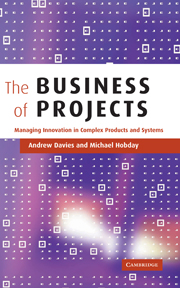Book contents
- Frontmatter
- Contents
- List of figures
- List of tables
- Foreword
- Acknowledgements
- Glossary
- 1 Introduction
- 2 The dynamics of innovation in complex products and systems
- 3 Business strategy and project capability
- 4 Systems integration and competitive advantage
- 5 The project-based organisation
- 6 Managing software-intensive projects
- 7 Learning in the project business
- 8 Integrated solutions for customers
- 9 Lessons for the project business
- Appendix A
- Appendix B
- Appendix C
- References
- Index
3 - Business strategy and project capability
Published online by Cambridge University Press: 22 September 2009
- Frontmatter
- Contents
- List of figures
- List of tables
- Foreword
- Acknowledgements
- Glossary
- 1 Introduction
- 2 The dynamics of innovation in complex products and systems
- 3 Business strategy and project capability
- 4 Systems integration and competitive advantage
- 5 The project-based organisation
- 6 Managing software-intensive projects
- 7 Learning in the project business
- 8 Integrated solutions for customers
- 9 Lessons for the project business
- Appendix A
- Appendix B
- Appendix C
- References
- Index
Summary
The previous chapter provides the broad context in which project-based activities are undertaken within a wide range of CoPS industries. This chapter shows more specifically how projects are used to improve a firm's operational effectiveness, achieve its strategic business objectives and enhance its competitive position. Drawing upon resource-based theories of the firm (Penrose, 1959; Richardson, 1972; Nelson and Winter, 1982; Wernerfelt, 1984; Teece and Pisano, 1994; Teece et al., 1997), the framework we introduce includes the definitions and concepts required to understand how a firm's project resources and capabilities form the basis of its growth and competitive advantage in project business. Following Penrose's (1959) original contribution, it is now well understood that organisational capabilities are critical to a firm's ability to mobilise and use its resources to grow and compete successfully in rapidly changing technologies and markets (Chandler, 1990; Grant, 2002). However, with a few exceptions (Amsden and Hikino, 1994; Cusumano and Nobeoka, 1998) the resource-based view of the firm has largely ignored the project as an organisational capability and source of competitive advantage.
In addition to the well-known strategic and functional capabilities of the firm described by Chandler (1990), we show how the concept of project capability explains how firms deploy projects to innovate and compete in dynamic markets. Effective bid and project management is necessary to improve a firm's operational performance in an existing technology or customer base. Projects are also used to implement corporate strategies to enter new fields of technology and create new markets.
- Type
- Chapter
- Information
- The Business of ProjectsManaging Innovation in Complex Products and Systems, pp. 56 - 87Publisher: Cambridge University PressPrint publication year: 2005



